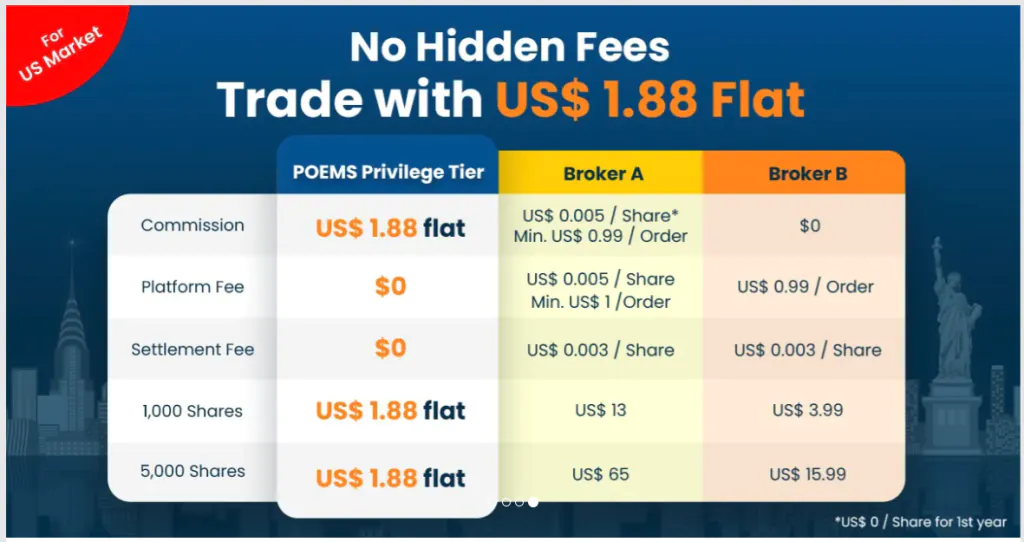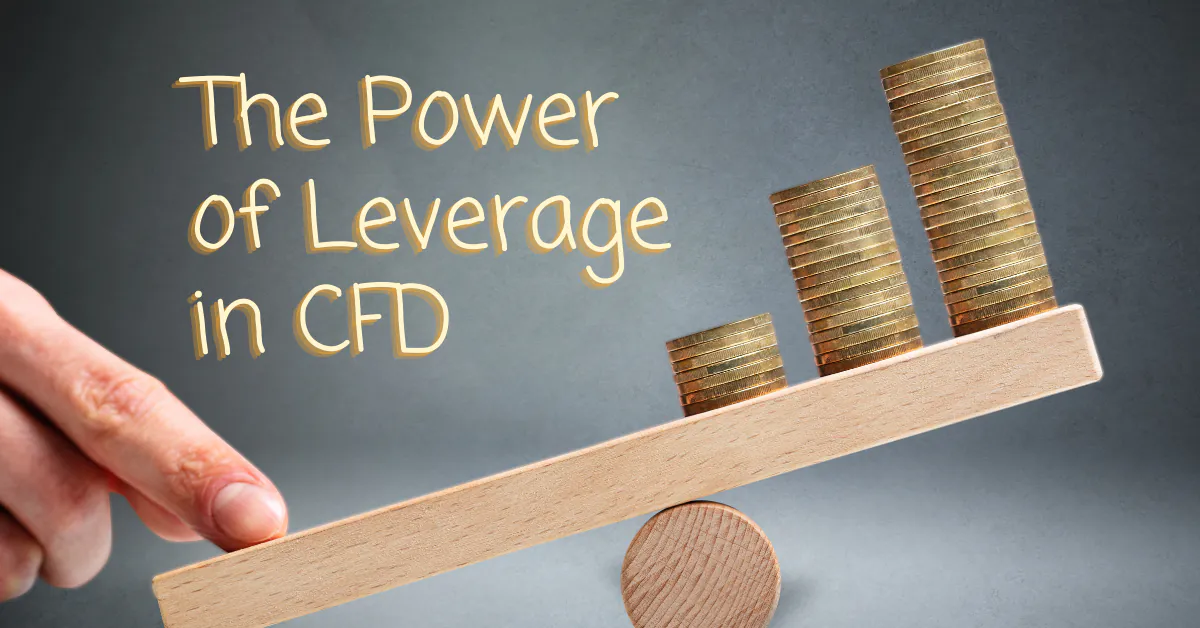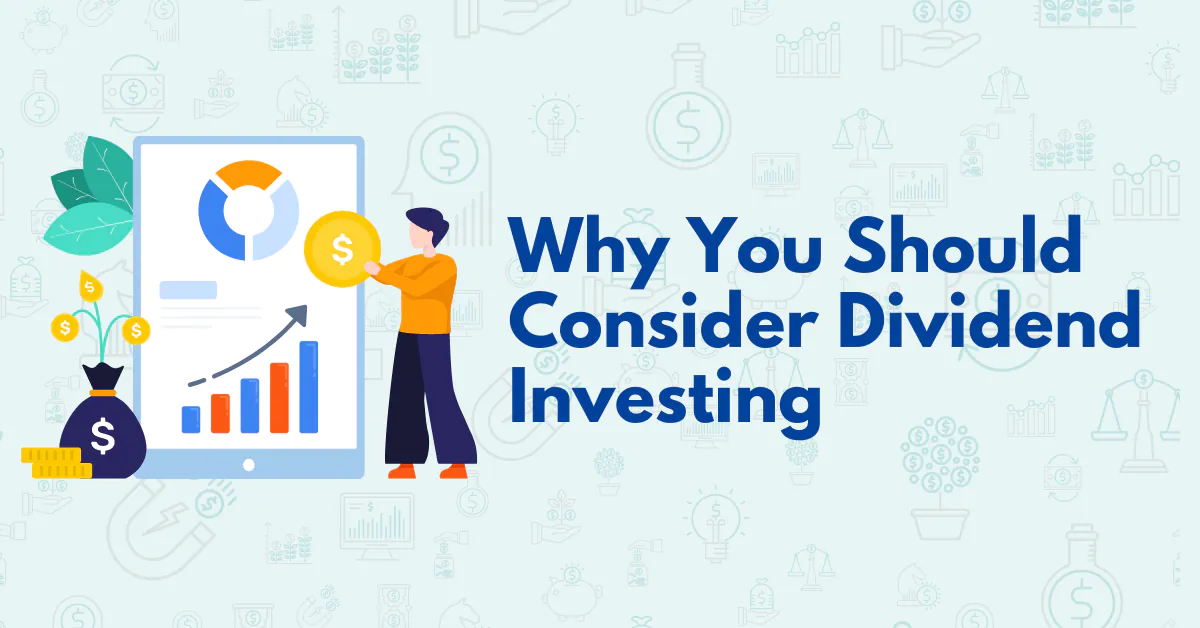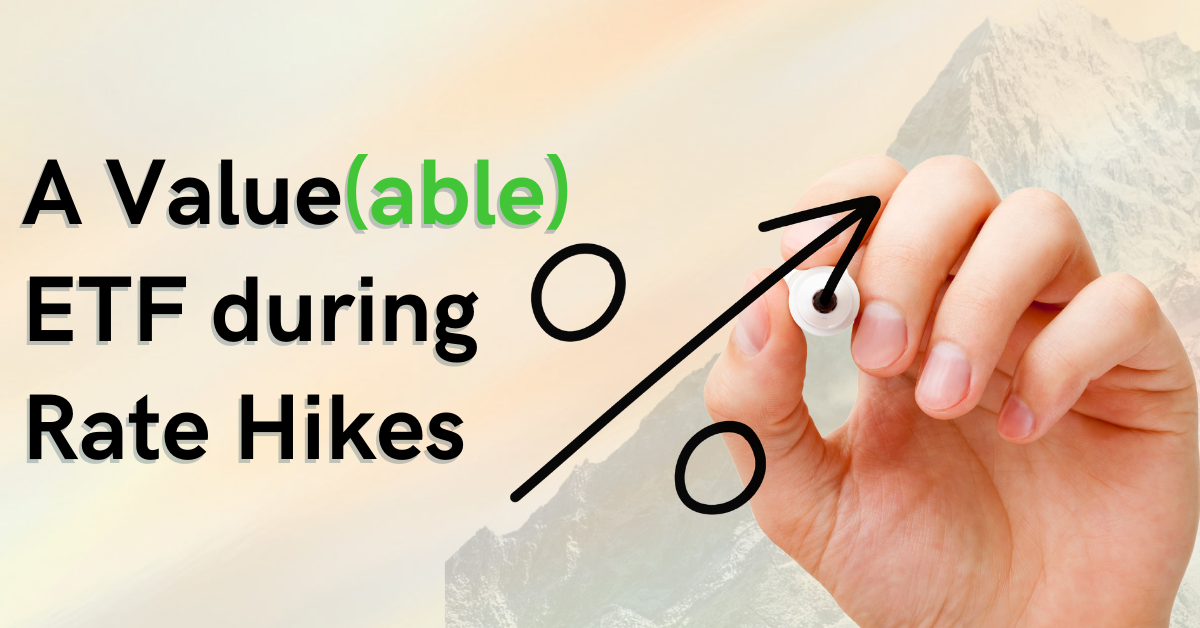2024: Expecting A Recession? These 3 Trade Ideas Could Help You To Flourish Despite It

Jeremy Chua, Senior Dealer
Jeremy graduated from Nanyang Technological University with a Bachelor’s Degree in Business and is a member of the largest dealing team in Phillip Securities. He strongly believes in the importance of staying invested in the financial markets and evaluates stocks using fundamentals to make informed investment decisions.
In his free time, he enjoys researching on market events and disruptive investment themes to generate new investment ideas for the short and long term.
Benjamin Tay, Senior Dealer
Benjamin graduated from the State University of New York at Buffalo with a Bachelor’s degree in Business Administration. He believes that a strong foundation is absolutely necessary to succeed in the financial markets. Therefore, he enjoys sharing his knowledge and experience to help others succeed.
In his free time, he enjoys reading books on business, fish keeping and spending time with his family.
With 2023 ending, amid speculation of a soft landing for the US economy, have you planned your investments for the coming new year?
With healthy employment numbers, easing inflation and strong consumer spending, it is no surprise that the Federal Reserve (Fed) expects a soft landing in 2023.
This expectation is further supported by the International Monetary Fund (IMF) and the Organisation for Economic Co-operation and Development’s (OECD) public announcement of a rebound in global growth in 2024.
However, we caution against taking current consensus forecasts at face value. While a scenario of moderating growth or mild recession is undoubtedly possible, there are several reasons for why things could turn out differently.

Source: FreePik Image [1]
Reason 1: Fed’s Track Record on Achieving a Soft Landing
While it is the goal to achieve a soft landing, the Fed’s track record has been mixed. The chart below shows each of the Fed’s hiking cycles since the 1970s (dark blue line), US inflation (light blue line), and recessions (shaded grey bars).
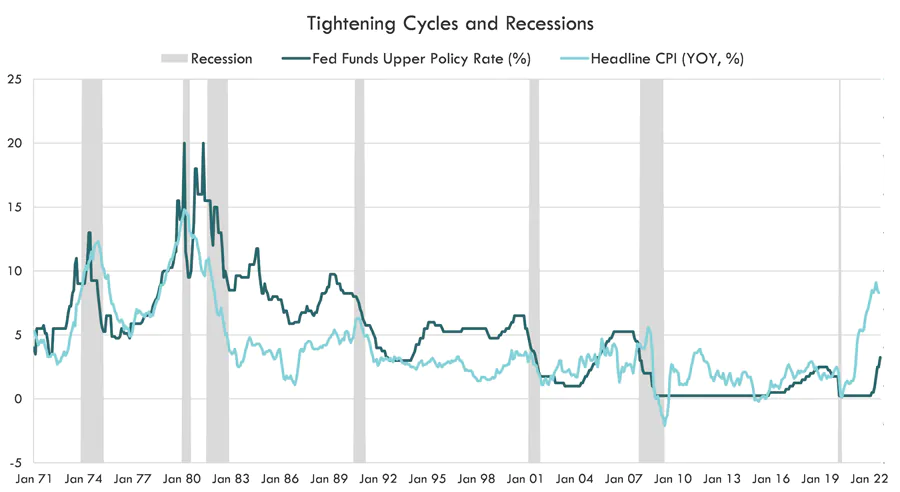
Source: Innovator ETFs [2]
In most instances, aggressive interest rate increases were followed – sometimes in very short order – by a recession. The only clear example of a successful soft landing was in the mid-1990s when the central bank raised interest rates from 3% to 6% without causing an economic downturn.
The recent rate hikes were the second most aggressive run in the Fed’s 110-year history. Apart from one rate-hiking cycle in the 1980s, every other round of interest rate hikes has been less severe than the current one, with a majority of them sparking a recession. Hence if history were any guide, we believe the likelihood of a soft landing is slim
Reason 2: Key Leading Indicators Pointing to a Possible Recession
Key Leading Indicator 1: Inverted Yield Curve
The yield curve is a line that plots the yield (or interest rates) of bonds with different maturities and equal credit quality. It becomes inverted when short-term bonds offer higher yields than long-term bonds, signalling short-term fear.
Throughout history, the inverted yield curve has consistently been a indication of an imminent recession, with the exception in 1966.
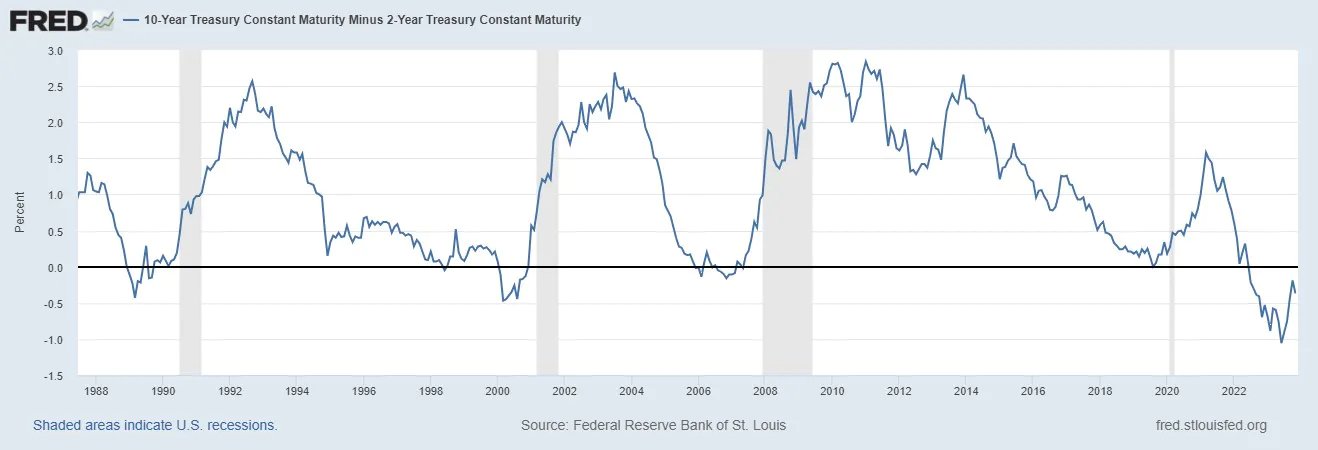
Source: Fred Economic Data [3]
With that in mind, let’s dive deep. When did the latest inversion of the yield curve begin?
The answer can be seen in the chart, July 2022, just one and a half years ago. It is a strong indication that a recession is highly probable.
Key Leading Indicator 2: Sahm Rule Indicator
Devised by former Fed economist Claudia Sahm, the Sahm Rule Indicator shows the difference between the current three-month and lowest three-month average unemployment rate for the past 12 months. The higher the unemployment rate, the wider the gap becomes, and the greater the Sahm Rule Indicator climbs. The Fed closely monitors this indicator as it serves as a robust employment tracker.
The Sahm Rule Indicator suggests that if the 3-month average unemployment rate rises by half a percentage point from its lowest level in the preceding 12 months, the economy is in a recession or will enter soon.
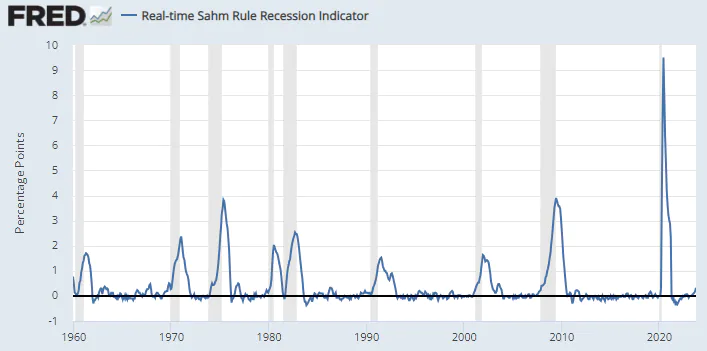
Source: Fred Economic Data [4]
Presently, the average three-month unemployment rate is 3.83%, while the lowest three-month rate over the last 12 months is 3.5%. That puts the Sahm Rule Indicator at 0.33% above its lowest level, meaning there’s roughly a 40% chance of a recession happening.
Key Leading Indicator 3: Depleting Savings
Consumer spending, the central argument for a soft landing, remains remarkably strong. The rationale for the argument is that all the out-of-hand inflation should have deterred the country from spending. However, this hasn’t happened (at least, not yet).
Millions of Americans were able to save during the pandemic, socking away stimulus checks and government benefits while skipping luxuries such as dining out and vacations. These handouts had shielded the economy from a massive recession.
According to the latest Fed study of household finances, all but the wealthiest 20% of Americans have spent those savings and now have less cash on hand than they did when the pandemic began. This is likely to dent consumer spending, which, let’s not forget, is the engine of the US economy.
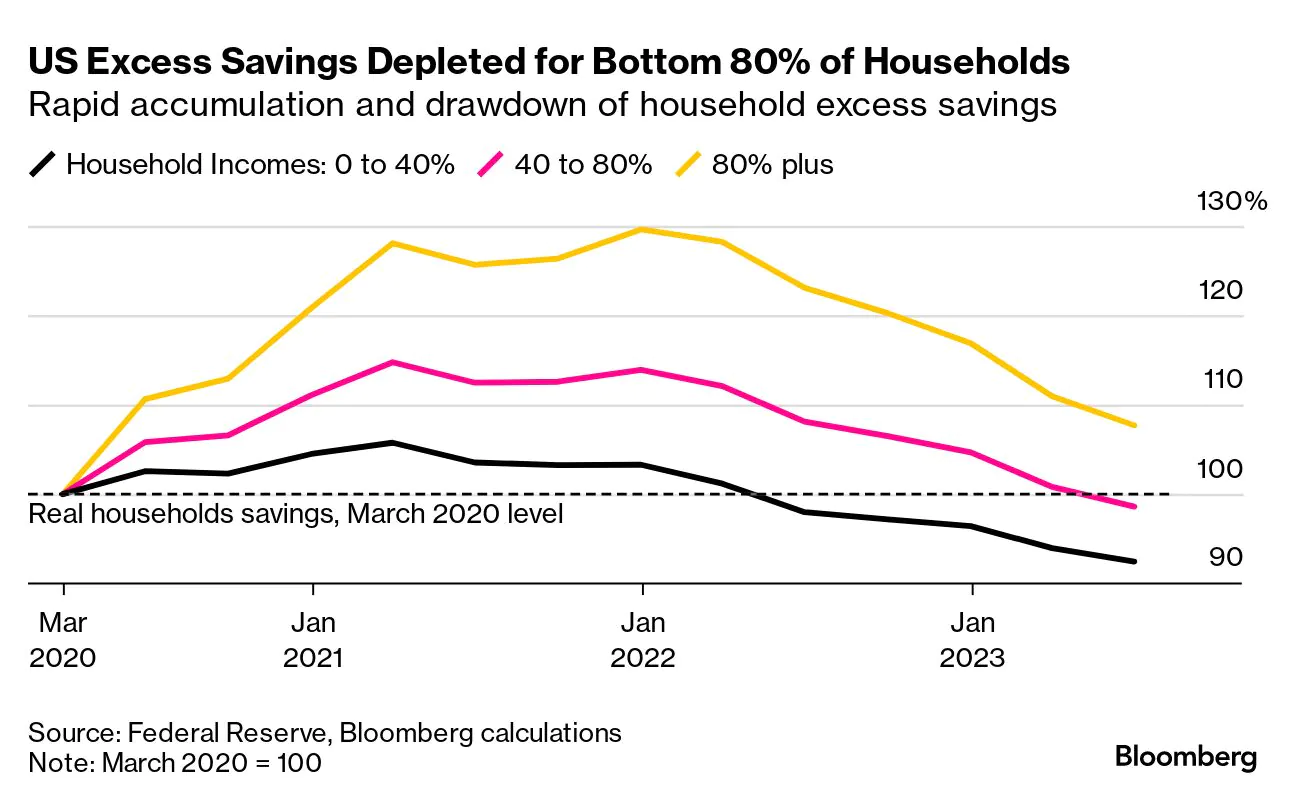
Source: Bloomberg [5]
With these three indicators hinting at an oncoming recession in 2024, are there three trade ideas that could potentially result in a prosperous 2024?
Trade Idea 1: iShares 20+ Treasury Bond ETF (Ticker: TLT)
Bonds have not been doing their job in the recent two years; they have been rising and falling in lockstep with stocks. After a huge drop, bonds are beginning to offer real value, particularly longer-dated US Treasury bonds.
Such bonds present a compelling investment thesis, thanks to their attractive risk-to-reward ratio and potentially negative return correlation with equities and other riskier assets.
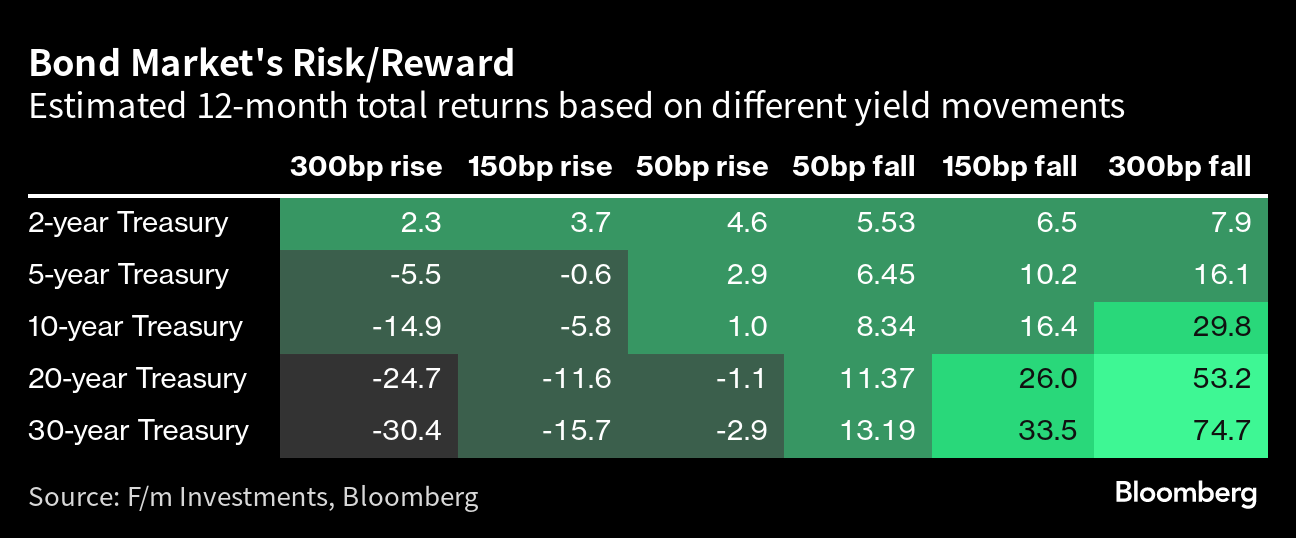
Source: Bloomberg [8]
Currently, a 20-year Treasury bond yields around 5%. Looking at the table, if the yields fall by half a percentage point, that same 20-year bond would return 11.3% over the next year. On the other hand, if yields rise by half a percentage point, they would lose just 1.1%. This equates roughly to a 1:11 risk-reward ratio. Hence, this risk-reward profile is one reason why the iShares 20+ Treasury Bond ETF (ticker: TLT) could be a good investment.
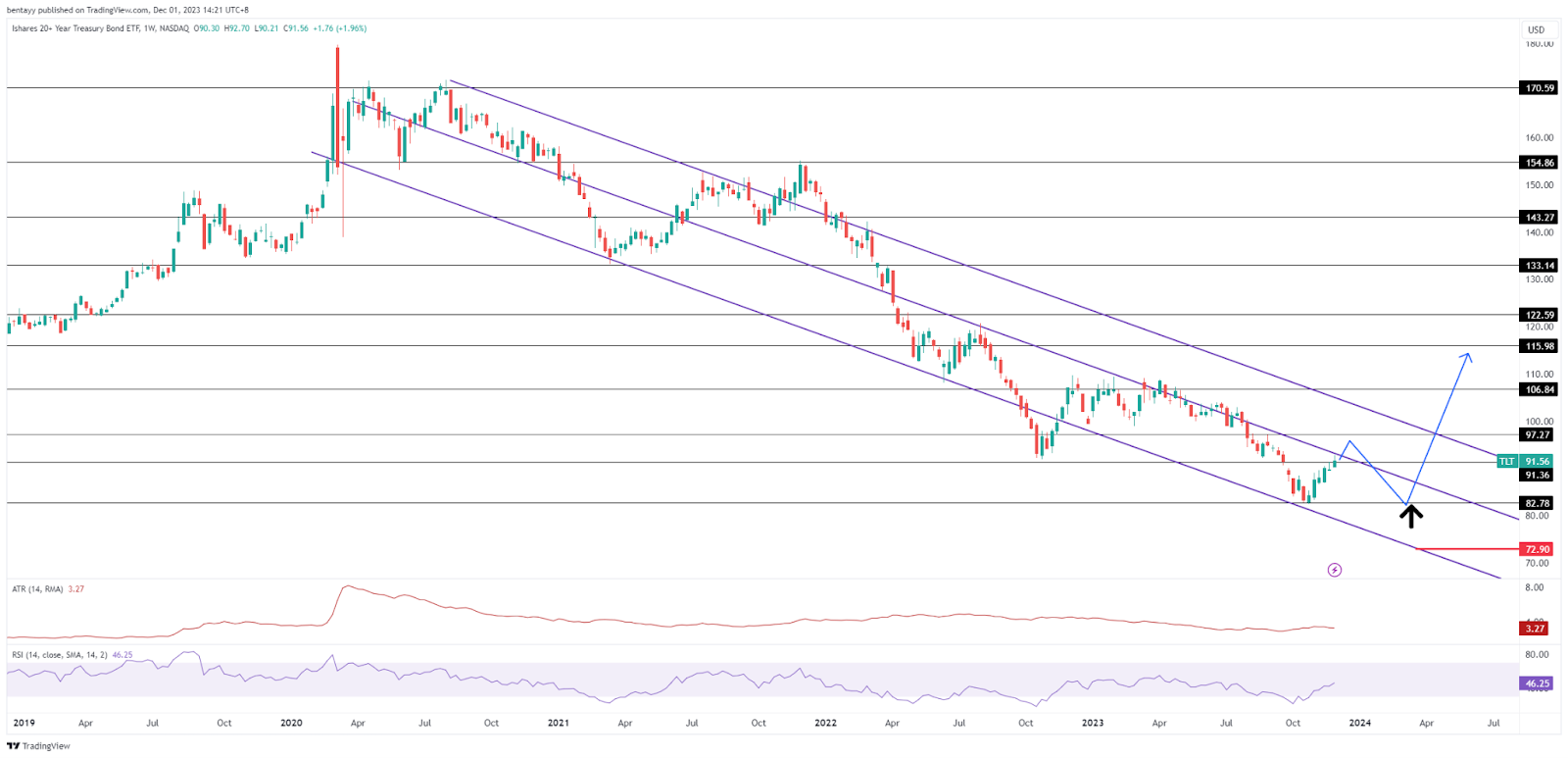
Source: tradingview.com [9]
With a possible drop in prices in the near term, the area of US$82.80 serves as a potential entry point with a stop loss around US$72.90 and a take profit area of around US$116.
Trade Idea 2: Energy Sector ETF (Ticker: XLE)
With Energy playing a significant part in our lives, powering businesses, transportation, entertainment, and more, would it be safe to assume that the Energy Sector is recession proof? Let’s go back in time to find out!
XLE is an ETF that tracks a market-cap-weighted index of US Energy companies in the S&P 500. It serves as a good indication of how the Energy Sector is performing.
During the Dotcom crash in March 2000, XLE continued to rise before tanking in May 2001.
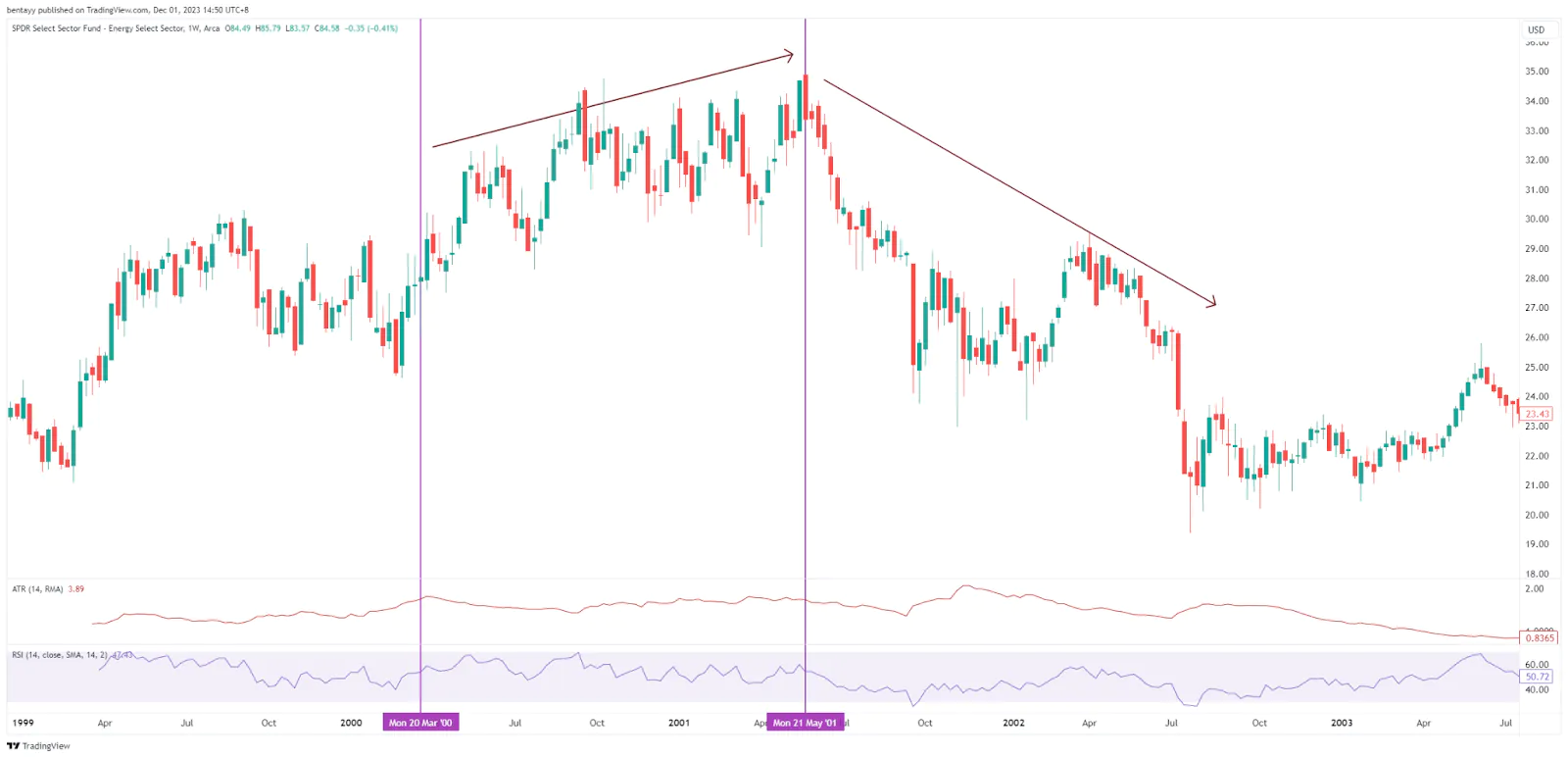
Source: tradingview.com [9]
In another example, The Great Financial Crisis in October 2007, XLE once again rose this time to a new all-time high in May 2008 before crashing.

Source: tradingview.com [9]
Assuming a recession hits sometime in 2024, based on its past behaviours, it is highly likely that XLE continues to rally before tanking.
Should that happen, the US$78.55 area acts as a good entry point, with prices expected to rebound after finding support. The US$100 mark represents a strong resistance area, making it suitable for profit taking, while a stop-loss can be placed at US$66.80

Source: tradingview.com [9]
Alternatively, should XLE struggle around US$100, it presents a potential opportunity for investors to go short instead. US$78.55 is a possible target for investors who plan on shorting in the short term, with a stop loss at US$117.
![Source: tradingview.com [9]](https://www.phillipcfd.com/wp-content/uploads/2023/12/5.png)
Source: tradingview.com [9]
For those planning to hold this trade for a longer term (e.g. until end of 2024), US$62.80 can be a profit taking target. Alternatively, investors can utilise a trailing stop loss, by regularly shifting their stop loss lower as XLE falls, to protect your profits.
Trade Idea 3: Consumer Discretionary Sector ETF (Ticker: XLY)
It is widely acknowledged that consumers are more stringent in spending during periods of economic downturn. In fact, such behaviours are noticeable even before the full impact of a recession is felt.
The Consumer Discretionary Sector ETF tracks the performance of companies in the specialty retail sector such as hotels, restaurants, luxury goods etc. Hence, it serves as a good indicator of consumer spending behaviour.
Looking at the chart below, before the Dotcom crash in March 2000, XLY peaked in December and started to fall prior to the event.
![Source: tradingview.com [9]](https://www.phillipcfd.com/wp-content/uploads/2023/12/6.png)
Source: tradingview.com [9]
Moving ahead to the Great Financial Crisis in October 2007, once again, XLY was already in decline since May 2007, prior to the crisis.
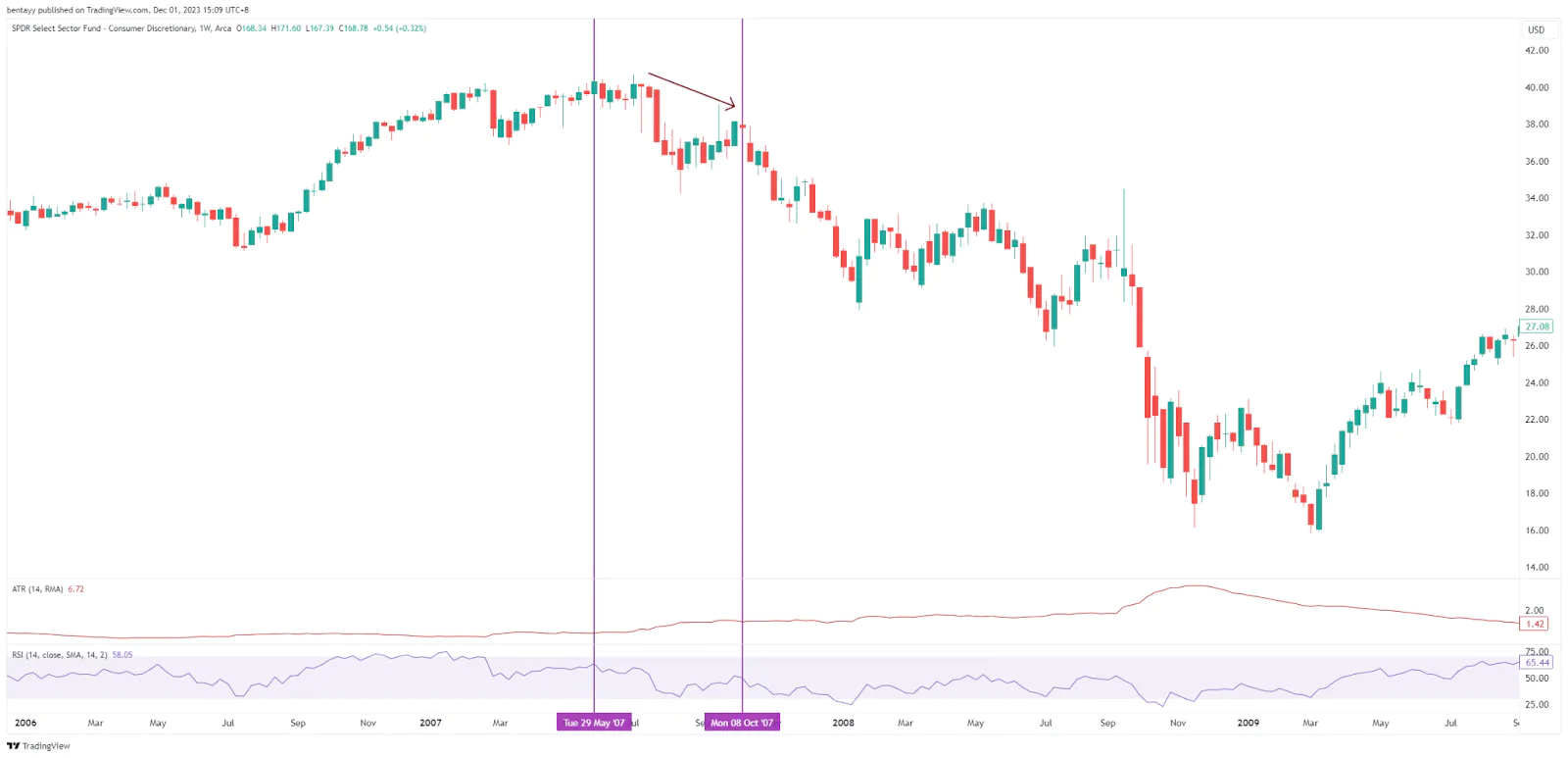
Source: tradingview.com [9]
Therefore, assuming a recession hits sometime in 2024 and if past performance is any indication of future behaviour, XLY could rise in 2024 before the stock market begins to fall.
In the short term, the US$157 is a support level that can serve as a good entry point for investors looking to long XLY, should the XLY pull back to this level. A potential take profit level would be around US$184.70 with a stop loss at US$136.90.
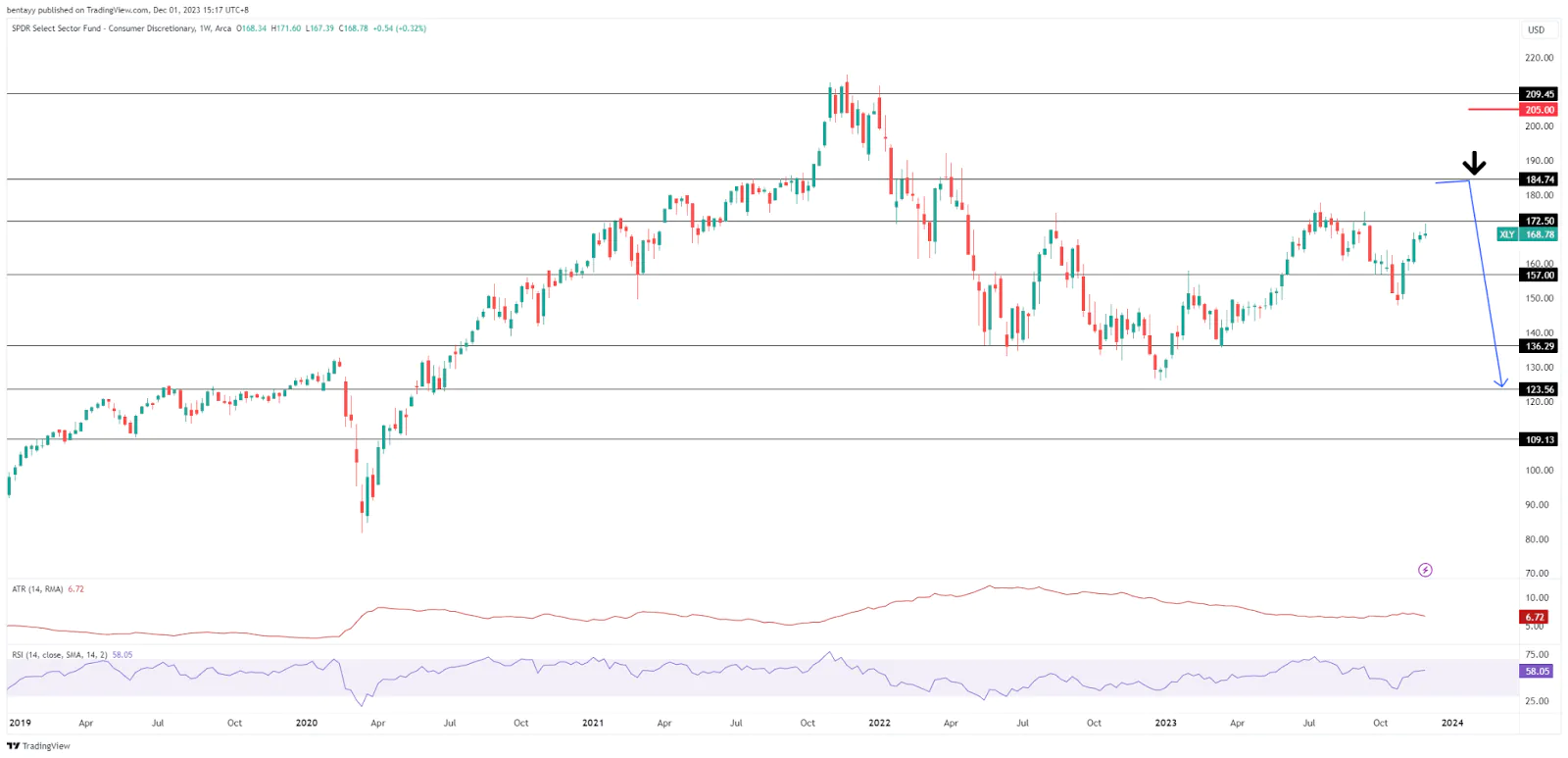
Source: tradingview.com [9]
On the other hand, if XLY does hit its support area at around US$184.70 and enters a bear market instead, investors may consider shorting the ETF. US$157 and US$123.50 price areas act as good profit taking targets for mid-term and long-term investors respectively, with a stop loss at US$205. Investors can also look for opportunities for having a trailing stop loss to protect their profits.

Source: tradingview.com [9]
How Can You Short XLE and XLY Safely?

Source: FreePik Image [10]
With the conventional wisdom of “buying low, sell high”, investors might be unfamiliar with going short on securities.
In fact, investors can short stocks, ETFs, and even currencies using Contract-for-difference (better known as CFD) which allows you to profit from rising and falling prices, so you will not be left on the side lines even when the market experiences a downturn.
That being said, CFD is a leveraged product. It is good practice for investors to set stop loss and take profit levels to help protect your trading capital and profits.
To further enhance your trading strategy, we have also recently conducted a Telegram Live session where our senior dealer, Ben, shared 4 huge benefits of having a stop loss and how it could benefit your trade.
Lastly, we encourage you to find out more about CFD on our website or contact us in preparation to thrive should a recession come our way.
Promotions

It’s your last chance to enjoy this promotion.
From now till 29 Dec 2023, enjoy up to S$120 cash credits* when you trade FX CFDs!
*T&Cs Apply. For more information, click here.
How to get started with POEMS
As the pioneer of Singapore’s online trading, POEMS’s award-winning suite of trading platforms offers investors and traders more than 40,000 financial products across global exchanges.
Explore an array of US shares with brokerage fees as low as US$1.88 flat* when you open a Cash Plus Account with us today. Find out more here (terms and conditions apply).
We hope that you have found value reading this article. If you do not have a POEMS account and are interested in trading, you may visit here to open an account with us today.
Lastly, investing in a community can be a highly rewarding experience. Here, you will have the opportunity to interact with us and other seasoned investors who are enthusiastic in sharing their experience and expertise whether it’s through listening or answering questions.
In this community, you will also gain exposure to quality educational materials and stock analysis, to help you appreciate the mindset of seasoned investors and apply concepts you have learned.
We look forward to sharing more insights with you in our growing and enthusiastic Telegram community. Join us now!
For enquiries, please email us at cfd@phillip.com.sg.
References
[2] https://www.innovatoretfs.com/blog/posts/historical-tightening-cycles.aspx
[3] https://fred.stlouisfed.org/series/T10Y2Y
[4] https://fred.stlouisfed.org/series/SAHMREALTIME
[6] https://www.bloomberg.com/markets/rates-bonds/government-bonds/us
[7] https://www.investopedia.com/terms/c/convexity.asp
More Articles
The Power of Leverage in CFD
What is leverage? Read our article to find out more about the different uses of leverage through the use of Contract for Differences (CFDs) for both traders and long-term investors.
Why You Should Consider Dividend Investing
Have you tried dividend investing? Learn more about why you should consider dividend investing!
A Value(able) ETF During Rate Hikes
Interested in buying valuable ETFs? Read on our article to find out more!
Disclaimer
This material is provided to you for general information only and does not constitute a recommendation, an offer or solicitation to buy or sell the investment product mentioned. It does not have any regard to your specific investment objectives, financial situation or any of your particular needs. Accordingly, no warranty whatsoever is given and not liability whatsoever is accepted for any loss arising whether directly or indirectly as a result of your acting based on this information.
Investments are subject to investment risks. The risk of loss in leveraged trading can be substantial. You may sustain losses in excess of your initial funds and may be called upon to deposit additional margin funds at short notice. If the required funds are not provided within the prescribed time, your positions may be liquidated. The resulting deficits in your account are subject to penalty charges. The value of investments denominated in foreign currencies may diminish or increase due to changes in the rates of exchange. You should also be aware of the commissions and finance costs involved in trading leveraged products. This product may not be suitable for clients whose investment objective is preservation of capital and/or whose risk tolerance is low. Clients are advised to understand the nature and risks involved in margin trading.
You may wish to obtain advice from a qualified financial adviser, pursuant to a separate engagement, before making a commitment to purchase any of the investment products mentioned herein. In the event that you choose not to obtain advice from a qualified financial adviser, you should assess and consider whether the investment product is suitable for you before proceeding to invest and we do not offer any advice in this regard unless mandated to do so by way of a separate engagement. You are advised to read the trading account Terms & Conditions and Risk Disclosure Statement (available online at www.poems.com.sg) before trading in this product.
Any CFD offered is not approved or endorsed by the issuer or originator of the underlying securities and the issuer or originator is not privy to the CFD contract. This advertisement has not been reviewed by the Monetary Authority of Singapore (MAS).





